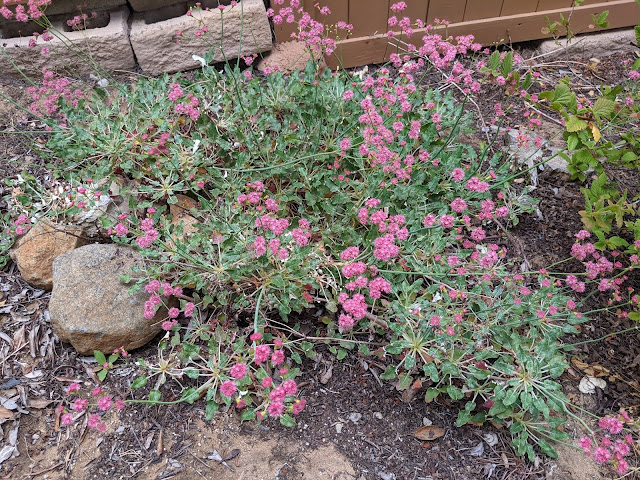This is part 2 of what's blooming in my garden right now.
White/Cream Flowers
I'll start with Baja California Spurge (Euphorbia xanti). Like the Baja Fairyduster, it is not native to our region but it is adaptable, very easy to grow, highly drought tolerant, and flowers abundantly in spring and summer. The plant consists of a dense cluster of densely branching stems that start out slender but become thicker and semi-woody with age. Mine has an unusual shape due to the way I keep it pruned. The flowers can be either white or pink on the same plant.
Next is a small tree, Blue Elderberry (Sambucus nigra caerulea). It is common and widespread in California, and it is an important wildlife plant. The flowers which appear in spring or summer are much valued by pollinators. In late summer clusters of small blue fruit are prized by various birds. If given plenty of water it will be evergreen, or deciduous if allowed to dry out in summer. Mine is never irrigated without effect on the flowers or fruit. Mine is also a somewhat unusual shape due to the way I keep it pruned.
Next up we have a foundational plant of our chaparral and coastal sage scrub - California Buckwheat (Eriogonum fasciculatum). This plant is abundant from the Bay Area down into Baja and is one of the most important pollinator plants. There are several horticultural varieties as well as other species that can be used. Mine is just the plain old species. It is literally crawling with pollinators right now.
Another option for Buckwheat is St. Cathrine's Lace (Eriogonum giganteum), a Channel Islands native. The flowers are similar to California Buckwheat, as you can see, but the leaves are considerably larger. Although it's a coastal plant in the wild, it is tolerant of a variety of conditions.
Concluding the white flowers, we have Matilija Poppy (Romney coulteri). It's a perennial herb that spreads from rhizomes. It goes semi-dormant in winter, not losing all its leaves but not growing until it warms up in spring. The rhizome means it will pop up where you least expect it or don't want it. Fortunately it is easy to control. The payoff is big, impressive flowers in summer. It is generally recommended to cut back all the stems in fall.
Pink/Purple Flowers
To finish up this review of summer bloomers, I have just a couple of plants with flowers in the pink/purple category. The first is another buckwheat, Red-Flowered Buckwheat (Eriogonum grande rubescens). It is native to the Channel Islands, and although the name is red-flowered, that's not accurate. It's really pink-flowered in my opinion.
The last plant is Blair's Cliffaster (Munzothamnus blairii). Yet another Channel Islands native, this species is more rare and seldom seen in gardens. I got mine from Tree of Life Nursery, and it is a solid performer. The leaves are pretty large compared with most of my other plants, producing a different visual texture. The flowers are great (obviously).













Wow, a Munzothamnus. I didn't think anyone had one in their garden. A very cool San Clemente Island endemic plant.
ReplyDelete